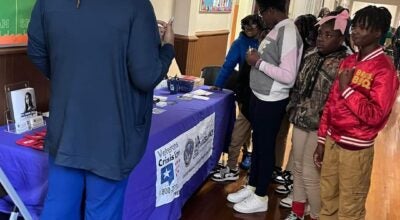McGuire brings Red Eagle’s bravery and honor to light in address to Lowndes County Historical and Genealogical Society
Published 12:02 pm Friday, November 3, 2017
|
Getting your Trinity Audio player ready...
|
By Fred Guarino
The Lowndes Signal
Trippy McGuire, retired Covington County district judge, brought home the history of William Weatherford “Red Eagle” at the Sunday, Oct. 29 meeting of the Lowndes County Historical and Genealogical Society at the historic CME Church in Lowndesboro.
It was also announced at the meeting that the Lowndesboro Heritage Society has started an “Alabama Room” for research at the Hanyneville/Lowndes County Public Library.
Weatherford, “Red Eagle,” escaped from the Battle of Holy Ground in Lowndes County by famously riding his horse off a buff into the Alabama River.
McGuire addressed the conflict the Creek Indian War put Weatherford in, who wanted peace with the Americans, and the honor and bravery Weatherford showed by his horse leap from the bluff in Lowndes County after the Battle of Holy Ground and his later walking into the tent of General Andrew Jackson to surrender to save the lives of Creek Indian women and children.
McGuire said he learned about Weatherford in fourth grade Alabama History. And he said his own father telling him that he grew up with the grandchildren (actually great-great-great grandchildren) of Weatherford stoked his interest.
McGuire said when he became a judge 1993, he resolved that when he retired he wanted to research Weatherford, which he said is still a work in progress.
He said both stories, the leap from the bluff and the surrender to Jackson attested to “Red Eagle’s bravery and sense of honor.”
Despite the fact that Weatherford’s grave says he was born in 1765, McGuire said that according to modern historians Red Eagle actually born in 1780 or 1781. And, he said, Weatherford’s Indian name of Hopnicafutsahia means “truth teller or truth seeker.”
McGuire made the case that Weatherford was opposed to Creek War against the Americans, but that he was forced into the conflict.
McGuire noted that Weatherford, called Lamochattee (Red Eagle), actually stood up against the Shawnee Chief Tecumseh when he came to stir the Indians of Alabama to go to war.
He quoted Weatherford saying, “When the Americans were weak and unprepared for war, they made the British Lion howl and drove him back into his den. Now that the Americans are strong, they will be more certain to conquer again.”
However, McGuire said, Tecumseh prevailed in his push for war against the Americans due to acts of wonder that followed his prophetic statements that people would see his arm stretched across the sky and that he would stop his feet three times and make the earth shake.
According to McGuire, in August and December of 1811 a comet appeared in the sky that could be seen with the naked eye. And he said three New Madrid earthquakes occurred between 1811 and 1812.
Another reason Weatherford joined in the war against the Americans, McGuire offered, was that hostile Creeks kidnapped Weatherford’s wife and children while he was away “to hold them hostage, threatening to kill them, if Weatherford did not come and join them.”
McGuire also said Weatherford thought he could prevent the hostile Creeks from committing murder on women and children, and that he thought he could convince the Creeks to take their own women and children to Florida out of harm’s way.
McGuire said Weatherford, however, was asked by the Creeks for an attack on Fort Mims because Americans housed there were involved in the Battle of Burn Corn where frontiersmen attacked a Red Sticks (Creek group advocating war) party.
According to McGuire, Weatherford had no expectation of taking Fort Mims. And, he said, Weatherford believed that once the Creeks were defeated, they would have no choice but to live with the Americans in peace.
McGuire also made the case that Weatherford did things to call attention to the Creeks pending attack as a means of alerting the Americans.
He said Weatherford made no secret of the long march to Fort Mims and delayed the march to allow time for word to spread.
However, McGuire said Major Daniel Beasley, who commanded the troops at Fort Mims believed the fort was in no danger of attack. He quoted Beasley saying, “Everyone knows that Indians don’t attack armed forts.”
More, McGuire said Weatherford talked to the Indians under his leadership about the fact that women and children were to be left alone, saying, “We come here to fight warriors not squaws.”
McGuire said Weatherford was haunted by the massacre at Fort Mims the rest of his life.
He said Weatherford’s secret plan for an Indian defeat failed “due to Beasley’s arrogance, drunkenness, refusal to believe warnings of witnesses, and an always open gate and fun and frolic instead of alert and ready.”
Coming into Lowndes County, McGuire said the Red Sticks built a fortification encompassing 50 acres known as the Holy Ground (Econochaca) because it has been consecrated by the Indians. And he said it became the base of Creek military operations in South Alabama.
He said on the morning of Dec. 23, 1813 the Americans were led by Sam Moniac, Weatherford’s own brother-in-law.
McGuire said Weatherford and about 30 or 40 Alabama Creeks stubbornly held their ground against overwhelming odds until only Weatherford and his uncle Malcolm McPherson were left.
He quoted George Stiggins on Weatherford’s famous escape saying, “The only avenue for them (Weatherford and McPherson) to escape was to leap off a bluff between 60 and 50 feet high at the junction of a creek and the river.”
Weatherford and his horse swam ashore unhurt and Weatherford’s uncle repeated the feat himself, McGuire said.
While McGuire said that the actual height of Weatherford’s leap varies according to various sources from 10 feet to 100 feet, he said, “However high it was, the soldiers that witnessed that leap were still talking about decades later, even at old age.”
The site of Holy Ground is located on a tributary once known as Holy Ground Creek off the Alabama River near White Hall.
But perhaps the biggest tribute McGuire paid to Weatherford’s honor was the story he related of Red Eagle’s resolve to surrender and appeal to General Andrew Jackson to send for the Creek woman and children and keep them supplied with food.
He was always driven by bravery, not fear, McGuire said.
McGuire related the story of how Weatherford walked into Jackson’s tent and introduced himself as Bill Weatherford. He quoted a recount of Weatherford’s words, “General Jackson, I’m not afraid of you. I fear no man for I’m a Creek warrior. I have nothing to request on behalf of myself. You can kill me if you desire. But I come to beg you to send for the women and children of the war party who are now starving in the woods. Their fields and cribs have been destroyed by your people. They were driven into the woods without an ear of corn. I hope you will send out parties who will safely conduct them here in order that they might be fed.”
He said Weatherford told how he asserted himself in vain to prevent the massacre of women and children at Fort Mims and that he was done fighting.
McGuire said Jackson response to calls for Weatherford’s death was, “To kill a man as brave as this would rob the dead.”
He quoted Judge A.B. Meek saying of Weatherford, “One of the most remarkable men whether savage or civilized, which the American hemisphere has produced. We know of no finer instance in Indian history of genius, heroism and helpfulness combined.”
For those interested, dues to join the Lowndes County Historical and Genealogical Society are $10 per individual or husband and wife. They may be mailed to Laura Howard, LCHGS treasurer, at P.O. Box 88, Lowndesboro, AL 36752.
Also, donations of books or other materials may be made to the Lowndesboro Historical Society Alabama Room at the Hayneville/Lowndes County Library. Contact Carolyn Parker at 334-278-3237 for more information.





